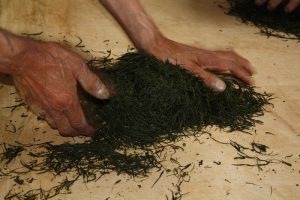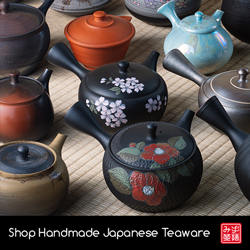
The temomi (手揉み, hand rolling) process for making sencha isn’t widely used nowadays because machines do all the work.
However, the tradition is still kept alive. It’s the basis for the design of the tea rolling machines themselves.
The basic concept for this was invented by Nagatani Soen.
Let’s take a look at the steps of the temomi process. By the way, there’s also a video about it at the end of this post.
Steaming (蒸熱, jounetsu)
The fresh tea leaves have to be steamed to stop oxidation, because a green tea must be minimally oxidized.
This step takes less than a minute, but it is crucial.
Once steaming is over, the leaves are carried to the hoirou (焙炉). This is a drying table made of wood, and generates heat by charcoal, or more recently gas and electricity.
On top of it is a large sheet of paper called jotan (助炭) which will be the surface to roll the leaves. It is heated to 110 °C (230 °F).
Haburui (葉ぶるい)
Also called tsuyukiri (露きり), this step lowers the moisture content of the leaves so that they become easier to roll.
Basically, the leaves are shaken and dropped into the jotan over and over again.
This steps lasts for about 30 to 50 minutes, and at the end the weight of the tea leaves decreases by 30%.
Kaitenmomi (回転揉み)
The moisture content inside the leaf is different than on its surface. To remedy this, a rolling technique known as kaitenmomi is used.
Bending the knees and using the weight of the upper body, the leaves are rolled with a set rhythm from side to side. This makes the leave’s cell walls break, and thus the flavor and aroma is enhanced.
As the moisture decreases, more pressure can be applied. There are three types of kaitenmomi used in this step, each applies more pressure than the previous one.
This steps last 40 to 50 minutes.
Tamatoki (玉解き) and Nakaage (中上げ)
In tamatoki, the leaves are rolled horizontally with little pressure so that lumps can be loosened.
Then, in nakaage, the leaves are taken out of the hot surface so that they can cool. At this stage some lumps are also loosened individually by hand.
This step takes about 10 minutes and the leaves lose 50% of their weight.
Meanwhile, the jotan is cleaned and dried for the next step.
Momikiri (揉み切り)
In this step the leaves are further rolled and their moisture decreases.
It looks similar to haburui because the leaves are dropped again. The difference is in the rolling motion done by the hands before they are dropped into the jotan.
The rolling force is applied by the little and index finger of each hand, and thus the tea leaves drop through the rest of the palm. This is done for half an hour.
Dengurimomi (でんぐり揉み)
Now the leaves are rolled against each other, and the color changes to dark green, with some luster.
The aroma improves greatly as well. Dengurimomi lasts 30 to 40 minutes.
Shiagemomi (仕上げ揉み)
This is the last rolling step, where sencha tea obtains its familiar needle shape.
Depending on the region, there are different methods. For example, we have momikirishiage, itazurishiage, and kokurishiage.
Kokuri is perhaps the most common, and it involves dividing an amount of tea into three sections, uniting it again and rolling with both hands. The idea is to keep mixing the tea leaves so that they are rolled evenly.
For beginners like me, this seems almost the same as dengurimomi 🙂
It goes on for 20 to 40 minutes.
Drying (乾燥, kansou)
The tea leaves are then spread evenly onto the jotan, which has now a temperature of 70 °C (158 °F). A hole is made in the middle so that heat can dissipate without burning the leaves.
I know that it’s hard to understand the process without watching it, so I included a video about it.
It’s made by Shizuka Maitani, who has contributed much to spreading Japanese tea culture with her great videos about Japanese tea. Enjoy!






February 17, 2016
This is great, thank you for sharing Ricardo!
February 17, 2016
Hi Gabriela
Thank you for reading and commenting 🙂
February 23, 2016
Hi Ricardo! Thank you very much for introducing my video! I am glad that you have written an article on temomi. It’s very difficult to explain temomi in words, you know. (^ ^)
February 23, 2016
Hi Shizuka
Thanks for recording the video. It is very well done.
February 26, 2016
Very informative. Thanks for sharing
February 26, 2016
Thank you Terry.
April 9, 2016
What exactly Jotan is & where can i get it for purchase?
April 9, 2016
Hi Thaneswar
It’s just a sheet of paper that goes on top of the table. I don’t know where to buy it, but I imagine that you can substitute it for another type of paper in case that you want to try rolling your own tea.
April 19, 2016
How can I make hoirou (the table) and what is jotan (paper) made of? Can I substitute it with a sheet of leather or something else?
April 19, 2016
Hi Thaneswar
Hoiro’s basic function can be achieved with just a metallic surface that is heated from below. Sort of like a version of a teppan grill, where teppanyaki cuisine is made.
The jotan is made of washi (和紙), a type of Japanese paper. I don’t know how to make it, so maybe it’s better to buy it.
June 22, 2017
Which metal is used for making the table’s(hoiro) metallic surface?
June 22, 2017
Hi Jefin
Thanks for your comment.
It looks like the top part is wooden, below is a metallic sheet and the whole thing can be heated with gas or by electricity.
I found this page for you to look at:
http://www.geocities.jp/temomihozonkai/newpage9.html
August 23, 2020
Thanks for the valuable information regarding Japanese Handrolled Green Tea.
I also manufacture of Handrolled Green Tea at Assam, India so it’s vary interesting.
Regards
Vedant Tea
Rakesh
Sivasagar, Assam, India
August 23, 2020
Hi Rakesh
Thank you for your comment. I wish you much success with your business.